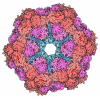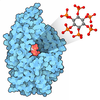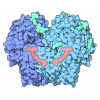+ Open data
Open data
- Basic information
Basic information
| Entry | Database: PDB / ID: 8yw2 | ||||||
|---|---|---|---|---|---|---|---|
| Title | Semliki Forest virus viron in complex with VLDLR | ||||||
 Components Components |
| ||||||
 Keywords Keywords | VIRAL PROTEIN / Semliki Forest virus viron / VLDLR | ||||||
| Function / homology |  Function and homology information Function and homology informationreelin receptor activity / VLDL clearance / glycoprotein transport / very-low-density lipoprotein particle receptor activity / ventral spinal cord development / Reelin signalling pathway / very-low-density lipoprotein particle binding / low-density lipoprotein particle receptor activity / very-low-density lipoprotein particle clearance / reelin-mediated signaling pathway ...reelin receptor activity / VLDL clearance / glycoprotein transport / very-low-density lipoprotein particle receptor activity / ventral spinal cord development / Reelin signalling pathway / very-low-density lipoprotein particle binding / low-density lipoprotein particle receptor activity / very-low-density lipoprotein particle clearance / reelin-mediated signaling pathway / very-low-density lipoprotein particle / positive regulation of dendrite development / cargo receptor activity / lipid transport / dendrite morphogenesis / regulation of synapse assembly / apolipoprotein binding / cholesterol metabolic process / clathrin-coated pit / receptor-mediated endocytosis / VLDLR internalisation and degradation / memory / calcium-dependent protein binding / nervous system development / receptor complex / lysosomal membrane / calcium ion binding / glutamatergic synapse / signal transduction / membrane / plasma membrane Similarity search - Function | ||||||
| Biological species |  Homo sapiens (human) Homo sapiens (human) Semliki Forest virus 4 Semliki Forest virus 4 | ||||||
| Method | ELECTRON MICROSCOPY / single particle reconstruction / cryo EM / Resolution: 3.7 Å | ||||||
 Authors Authors | Wang, J. / Zheng, T. / Yang, D. | ||||||
| Funding support | 1items
| ||||||
 Citation Citation |  Journal: To Be Published Journal: To Be PublishedTitle: Structure of Semliki Forest virus in complex with VLDLR Authors: Zheng, T. | ||||||
| History |
|
- Structure visualization
Structure visualization
| Structure viewer | Molecule:  Molmil Molmil Jmol/JSmol Jmol/JSmol |
|---|
- Downloads & links
Downloads & links
- Download
Download
| PDBx/mmCIF format |  8yw2.cif.gz 8yw2.cif.gz | 2.8 MB | Display |  PDBx/mmCIF format PDBx/mmCIF format |
|---|---|---|---|---|
| PDB format |  pdb8yw2.ent.gz pdb8yw2.ent.gz | Display |  PDB format PDB format | |
| PDBx/mmJSON format |  8yw2.json.gz 8yw2.json.gz | Tree view |  PDBx/mmJSON format PDBx/mmJSON format | |
| Others |  Other downloads Other downloads |
-Validation report
| Summary document |  8yw2_validation.pdf.gz 8yw2_validation.pdf.gz | 2.4 MB | Display |  wwPDB validaton report wwPDB validaton report |
|---|---|---|---|---|
| Full document |  8yw2_full_validation.pdf.gz 8yw2_full_validation.pdf.gz | 2.4 MB | Display | |
| Data in XML |  8yw2_validation.xml.gz 8yw2_validation.xml.gz | 374.8 KB | Display | |
| Data in CIF |  8yw2_validation.cif.gz 8yw2_validation.cif.gz | 612.6 KB | Display | |
| Arichive directory |  https://data.pdbj.org/pub/pdb/validation_reports/yw/8yw2 https://data.pdbj.org/pub/pdb/validation_reports/yw/8yw2 ftp://data.pdbj.org/pub/pdb/validation_reports/yw/8yw2 ftp://data.pdbj.org/pub/pdb/validation_reports/yw/8yw2 | HTTPS FTP |
-Related structure data
| Related structure data |  39620MC M: map data used to model this data C: citing same article ( |
|---|---|
| Similar structure data | Similarity search - Function & homology  F&H Search F&H Search |
- Links
Links
- Assembly
Assembly
| Deposited unit | 
|
|---|---|
| 1 |
|
- Components
Components
-Spike glycoprotein ... , 3 types, 48 molecules 02AAABLMNSabcgluvw456EFGHUVWhimo...
| #1: Protein | Mass: 5848.729 Da / Num. of mol.: 16 / Source method: isolated from a natural source / Source: (natural)  Semliki Forest virus 4 / References: UniProt: A0A0E3T652 Semliki Forest virus 4 / References: UniProt: A0A0E3T652#3: Protein | Mass: 47489.766 Da / Num. of mol.: 16 / Source method: isolated from a natural source / Source: (natural)  Semliki Forest virus 4 / References: UniProt: A0A0E3T652 Semliki Forest virus 4 / References: UniProt: A0A0E3T652#4: Protein | Mass: 46468.867 Da / Num. of mol.: 16 / Source method: isolated from a natural source Details: Molecular name is based on https://www.ebi.ac.uk/interpro/protein/UniProt/A0A0E3T652/ as Uniprot Reference A0A0E3T652 and author provided name are both Structural polyprotein. Source: (natural)  Semliki Forest virus 4 / References: UniProt: A0A0E3T652 Semliki Forest virus 4 / References: UniProt: A0A0E3T652 |
|---|
-Protein , 2 types, 17 molecules 13ACADAEDOPQTdefnxyA
| #2: Protein | Mass: 17791.299 Da / Num. of mol.: 16 / Source method: isolated from a natural source / Source: (natural)  Semliki Forest virus 4 / References: UniProt: A0A0E3T652 Semliki Forest virus 4 / References: UniProt: A0A0E3T652#5: Protein | | Mass: 17585.789 Da / Num. of mol.: 1 Source method: isolated from a genetically manipulated source Source: (gene. exp.)  Homo sapiens (human) / Gene: VLDLR / Production host: Homo sapiens (human) / Gene: VLDLR / Production host:  Homo sapiens (human) / References: UniProt: P98155 Homo sapiens (human) / References: UniProt: P98155 |
|---|
-Sugars , 1 types, 48 molecules
| #6: Polysaccharide | beta-D-mannopyranose-(1-4)-2-acetamido-2-deoxy-beta-D-glucopyranose-(1-4)-2-acetamido-2-deoxy-beta- ...beta-D-mannopyranose-(1-4)-2-acetamido-2-deoxy-beta-D-glucopyranose-(1-4)-2-acetamido-2-deoxy-beta-D-glucopyranose Source method: isolated from a genetically manipulated source |
|---|
-Details
| Has ligand of interest | N |
|---|---|
| Has protein modification | Y |
-Experimental details
-Experiment
| Experiment | Method: ELECTRON MICROSCOPY |
|---|---|
| EM experiment | Aggregation state: PARTICLE / 3D reconstruction method: single particle reconstruction |
- Sample preparation
Sample preparation
| Component | Name: Semliki Forest viron / Type: COMPLEX / Entity ID: #1-#5 / Source: RECOMBINANT | ||||||||||||
|---|---|---|---|---|---|---|---|---|---|---|---|---|---|
| Source (natural) |
| ||||||||||||
| Source (recombinant) | Organism:  Homo sapiens (human) Homo sapiens (human) | ||||||||||||
| Buffer solution | pH: 7.5 | ||||||||||||
| Specimen | Embedding applied: NO / Shadowing applied: NO / Staining applied: NO / Vitrification applied: YES | ||||||||||||
| Vitrification | Cryogen name: ETHANE / Humidity: 100 % |
- Electron microscopy imaging
Electron microscopy imaging
| Microscopy | Model: FEI TITAN |
|---|---|
| Electron gun | Electron source:  FIELD EMISSION GUN / Accelerating voltage: 300 kV / Illumination mode: FLOOD BEAM FIELD EMISSION GUN / Accelerating voltage: 300 kV / Illumination mode: FLOOD BEAM |
| Electron lens | Mode: BRIGHT FIELD / Nominal defocus max: 3000 nm / Nominal defocus min: 1200 nm |
| Image recording | Electron dose: 50 e/Å2 / Film or detector model: FEI FALCON IV (4k x 4k) |
- Processing
Processing
| CTF correction | Type: PHASE FLIPPING AND AMPLITUDE CORRECTION |
|---|---|
| 3D reconstruction | Resolution: 3.7 Å / Resolution method: FSC 0.143 CUT-OFF / Num. of particles: 33471 / Symmetry type: POINT |
 Movie
Movie Controller
Controller



 PDBj
PDBj






